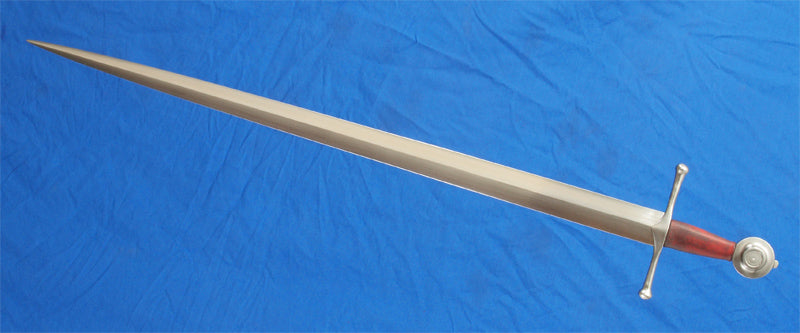Today we have a word or two in support of the one handed sword. The most common style of sword throughout the medieval period can get a bit of short shrift today as the popularity of the longsword can dominate in the popular culture of entertainment and historical martial arts.
The sword in one hand, often called an "arming sword" in the medieval period, was an exceptionally versatile weapon. It was used in the agile combat of the norse raider as well as the knights of the early feudal systems across Europe. As a weapon worn whenever protection was needed or danger threatened, it became a symbol of the knightly class. Many depictions of kings and chieftains are seen seated on their thrones with a sword across their lap.

Lewis Chess Man at The British Museum
This symbol of authority, power, and the monarch's role as a defender of the realm is seen across history. Placing the sword across the lap visually reinforced the ruler's responsibility and control of their domain. The commitment to justice and the fair application of law being an attribute that was seen to be just as important as maintaining order and protecting the well-being of the people.
Historical Significance
These swords have played a pivotal role in war across the ages, even before and after the medieval period. In any battle where the sword was used, the single handed blade would be the more common weapon. In today's video we look at several of our one handed sword replicas and a bit of how important and functional these weapons were.
In the realm of weapons, the one-handed sword stands out as the choice of warriors for many ages, right into the modern world. Its efficiency in materials and use was a major factor in its continued use and evolution. It also became a symbol of leadership and the hero in legends as well as popular culture even today.
From its historical significance to the modern appreciation for a well crafted sword, these blades offer a singular joy that resonates with warriors, collectors, and enthusiasts alike. Whether on display or being wielded in training, the one-handed sword is a testament to the enduring fascination with the marriage of form and function in the world of the blade.

Nathan Clough, Ph.D. is Vice President of Arms and Armor and a member of the governing board of The Oakeshott Institute. He is a historical martial artist and a former university professor of cultural geography. He has given presentations on historical arms at events including Longpoint and Combatcon, and presented scholarly papers at, among others, The International Congress on Medieval Studies.
Craig Johnson is the Production Manager of Arms and Armor and Secretary of The Oakeshott Institute. He has taught and published on the history of arms, armor and western martial arts for over 30 years. He has lectured at several schools and Universities, WMAW, HEMAC, 4W, and ICMS at Kalamazoo. His experiences include iron smelting, jousting, theatrical combat instruction and choreography, historical research, European martial arts and crafting weapons and armor since 1985





